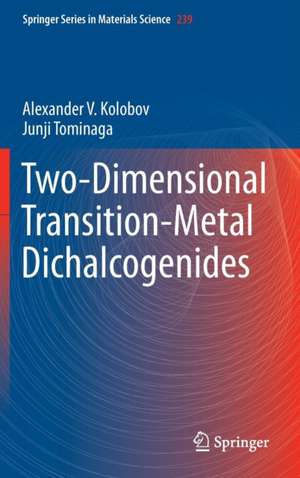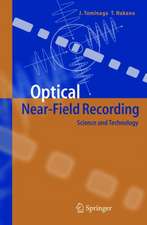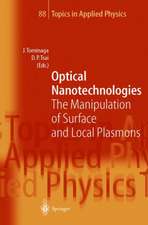Two-Dimensional Transition-Metal Dichalcogenides: Springer Series in Materials Science, cartea 239
Autor Alexander V. Kolobov, Junji Tominagaen Limba Engleză Hardback – 4 aug 2016
Starting with the basic chemistry of transition metals, the reader is introduced to the rich field of transition metal dichalcogenides. After a chapter on three dimensional crystalsand a description of top-down and bottom-up fabrication methods of few-layer and single layer structures, the fascinating world of two-dimensional TMDCs structures is presented with their unique atomic, electronic, and magnetic properties. The book covers in detail particular features associated with decreased dimensionality such as stability and phase-transitions in monolayers, the appearance of a direct gap, large binding energy of 2D excitons and trions and their dynamics, Raman scattering associated with decreased dimensionality, extraordinarily strong light-matter interaction, layer-dependent photoluminescence properties, new physics associated with the destruction of the spatial inversion symmetry of the bulk phase, spin-orbit and spin-valley couplings. The book concludes with chapters on engineered heterostructures and device applications such as a monolayer MoS2 transistor.
Considering the explosive interest in physics and applications of two-dimensional materials, this book is a valuable source of information for material scientists and engineers working in the field as well as for the graduate students majoring in materials science.
| Toate formatele și edițiile | Preț | Express |
|---|---|---|
| Paperback (1) | 1828.11 lei 6-8 săpt. | |
| Springer International Publishing – 22 apr 2018 | 1828.11 lei 6-8 săpt. | |
| Hardback (1) | 1834.44 lei 6-8 săpt. | |
| Springer International Publishing – 4 aug 2016 | 1834.44 lei 6-8 săpt. |
Din seria Springer Series in Materials Science
- 18%
 Preț: 1820.22 lei
Preț: 1820.22 lei - 18%
 Preț: 776.09 lei
Preț: 776.09 lei - 24%
 Preț: 689.69 lei
Preț: 689.69 lei - 18%
 Preț: 968.96 lei
Preț: 968.96 lei - 20%
 Preț: 568.95 lei
Preț: 568.95 lei - 18%
 Preț: 953.65 lei
Preț: 953.65 lei - 18%
 Preț: 902.36 lei
Preț: 902.36 lei - 18%
 Preț: 953.65 lei
Preț: 953.65 lei - 20%
 Preț: 948.42 lei
Preț: 948.42 lei - 18%
 Preț: 1143.07 lei
Preț: 1143.07 lei - 18%
 Preț: 1111.53 lei
Preț: 1111.53 lei - 18%
 Preț: 1103.62 lei
Preț: 1103.62 lei - 18%
 Preț: 1225.94 lei
Preț: 1225.94 lei -
 Preț: 473.91 lei
Preț: 473.91 lei - 18%
 Preț: 782.42 lei
Preț: 782.42 lei -
 Preț: 433.47 lei
Preț: 433.47 lei - 18%
 Preț: 1116.40 lei
Preț: 1116.40 lei - 18%
 Preț: 946.24 lei
Preț: 946.24 lei - 18%
 Preț: 945.20 lei
Preț: 945.20 lei - 18%
 Preț: 1114.21 lei
Preț: 1114.21 lei - 15%
 Preț: 641.20 lei
Preț: 641.20 lei - 18%
 Preț: 958.56 lei
Preț: 958.56 lei - 18%
 Preț: 1224.36 lei
Preț: 1224.36 lei - 15%
 Preț: 644.82 lei
Preț: 644.82 lei - 24%
 Preț: 833.45 lei
Preț: 833.45 lei - 24%
 Preț: 1060.36 lei
Preț: 1060.36 lei - 18%
 Preț: 964.10 lei
Preț: 964.10 lei - 18%
 Preț: 1224.36 lei
Preț: 1224.36 lei - 18%
 Preț: 1221.20 lei
Preț: 1221.20 lei - 18%
 Preț: 946.87 lei
Preț: 946.87 lei - 18%
 Preț: 1836.92 lei
Preț: 1836.92 lei - 15%
 Preț: 643.34 lei
Preț: 643.34 lei - 18%
 Preț: 1246.32 lei
Preț: 1246.32 lei - 18%
 Preț: 956.81 lei
Preț: 956.81 lei - 18%
 Preț: 953.52 lei
Preț: 953.52 lei - 15%
 Preț: 637.59 lei
Preț: 637.59 lei
Preț: 1834.44 lei
Preț vechi: 2237.13 lei
-18% Nou
Puncte Express: 2752
Preț estimativ în valută:
351.00€ • 366.52$ • 289.86£
351.00€ • 366.52$ • 289.86£
Carte tipărită la comandă
Livrare economică 15-29 aprilie
Preluare comenzi: 021 569.72.76
Specificații
ISBN-13: 9783319314495
ISBN-10: 3319314491
Pagini: 464
Ilustrații: XVII, 538 p. 378 illus., 292 illus. in color.
Dimensiuni: 155 x 235 x 30 mm
Greutate: 0.95 kg
Ediția:1st ed. 2016
Editura: Springer International Publishing
Colecția Springer
Seria Springer Series in Materials Science
Locul publicării:Cham, Switzerland
ISBN-10: 3319314491
Pagini: 464
Ilustrații: XVII, 538 p. 378 illus., 292 illus. in color.
Dimensiuni: 155 x 235 x 30 mm
Greutate: 0.95 kg
Ediția:1st ed. 2016
Editura: Springer International Publishing
Colecția Springer
Seria Springer Series in Materials Science
Locul publicării:Cham, Switzerland
Cuprins
Introduction.- Chemistry of Transition Metal Dichalcogenides.- Brief Review of Bulk TMDCs: Structure and Properties.- Fabrication of 2D TMDC.- Structure of Monolayer and Few-Layer TMDCs.- Band Structure of 2D TMDCs.- Raman Scattering Spectroscopy of 2D TMDCs.- Photoluminescence of 2D TMDC.- Excitons in 2D TMDCs.- Magnetism of 2D TMDCs.- Spin-Valley Coupling in 2D TMDCs.- Miscellaneous Phenomena.- Functionalization of 2D TMDCs.- TMDC Heterostructures.- Applications of 2D TMDCs.
Recenzii
“This book of more than 500 pages about 2-D transitional-metaldichalcogenides (TMDs) covers one of the most important research subjects in recent years, since the 2-D TMD is the largest family of atomically thin materials studied after graphene. … The book has beautiful color illustrations and tens of references at the end of each chapter. It is a must for anyone working in optics.” (Mircea Dragoman, Optics & Photonics News, osa-opn-org, February, 2017)
Notă biografică
Textul de pe ultima copertă
This book summarizes the current status of theoretical and experimental progress in 2 dimensional graphene-like monolayers and few-layers of transition metal dichalcogenides (TMDCs). Semiconducting monolayer TMDCs, due to the presence of a direct gap, significantly extend the potential of low-dimensional nanomaterials for applications in nanoelectronics and nano-optoelectronics as well as flexible nano-electronics with unprecedented possibilities to control the gap by external stimuli. Strong quantum confinement results in extremely high exciton binding energies which forms an interesting platform for both fundamental studies and device applications. Breaking of spatial inversion symmetry in monolayers results in strong spin-valley coupling potentially leading to their use in valleytronics.
Starting with the basic chemistry of transition metals, the reader is introduced to the rich field of transition metal dichalcogenides. After a chapter on three dimensional crystalsand a description of top-down and bottom-up fabrication methods of few-layer and single layer structures, the fascinating world of two-dimensional TMDCs structures is presented with their unique atomic, electronic, and magnetic properties. The book covers in detail particular features associated with decreased dimensionality such as stability and phase-transitions in monolayers, the appearance of a direct gap, large binding energy of 2D excitons and trions and their dynamics, Raman scattering associated with decreased dimensionality, extraordinarily strong light-matter interaction, layer-dependent photoluminescence properties, new physics associated with the destruction of the spatial inversion symmetry of the bulk phase, spin-orbit and spin-valley couplings. The book concludes with chapters on engineered heterostructures and device applications such as a monolayer MoS2 transistor.
Considering the explosive interest in physics and applications of two-dimensional materials, this book is a valuable source of information for material scientists and engineers working in the field as well as for the graduate students majoring in materials science.
Starting with the basic chemistry of transition metals, the reader is introduced to the rich field of transition metal dichalcogenides. After a chapter on three dimensional crystalsand a description of top-down and bottom-up fabrication methods of few-layer and single layer structures, the fascinating world of two-dimensional TMDCs structures is presented with their unique atomic, electronic, and magnetic properties. The book covers in detail particular features associated with decreased dimensionality such as stability and phase-transitions in monolayers, the appearance of a direct gap, large binding energy of 2D excitons and trions and their dynamics, Raman scattering associated with decreased dimensionality, extraordinarily strong light-matter interaction, layer-dependent photoluminescence properties, new physics associated with the destruction of the spatial inversion symmetry of the bulk phase, spin-orbit and spin-valley couplings. The book concludes with chapters on engineered heterostructures and device applications such as a monolayer MoS2 transistor.
Considering the explosive interest in physics and applications of two-dimensional materials, this book is a valuable source of information for material scientists and engineers working in the field as well as for the graduate students majoring in materials science.
Caracteristici
Provides a systematic description of the whole class of 2D TMDCs Contains necessary background such as a chapter on chemistry of transition metals and a brief review of bulk TMDCs Describes various aspects of transition-metal dichalcogenides Includes supplementary material: sn.pub/extras









